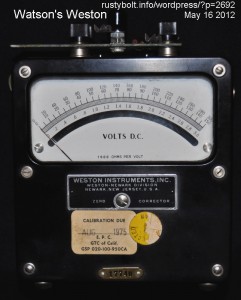A long time ago I wanted to get a digital panel meter that is small, uses very little power (LCD display), and does not require a power source that is floating, in other words it can be powered from the same power supply that it’s measuring. When it’s measuring current, this is important, since both measuring leads are nearly at the same voltage. It seemed like every digital panel meter I came across required that the power be independent and isolated from the measuring leads. I got discouraged and gave up trying to find one.
Several years ago I was lucky to buy this Weston mirror backed voltmeter at an ATCA telephone collectors show. It has a 3V range, which I extended to 15V with the precision resistors that I mounted on a piece of PC board, and screwed down to the top using the meter’s binding posts. It uses a 1 milliamp movement, hence the label “1000 ohms per volt”.
Its accuracy is uncanny: I can eyeball the needle using the mirror to get rid of the parallax, and using the needle, set the power supply voltage to what looks like exactly 1.5V. Then I put the DVM on the power supply, and incredibly the voltage is within 5 to 10 millivolts of 1.5V. Its disdvantage is that it loads the circuit down with up to 1 milliamp of current, so measuring a higher resistance circuit is not going to be accurate. But it’s great for setting the cheap power supply that has a 3 digit digital meter with only a single digit to the right of the decimal point.
Yeah, it’s big and bulky and it needs calibration. But it’s probably been around longer than most of us have been alive, and it’s still almost as accurate as a DMM. The GTC of California sticker means it was property of General Telephone of California, a division of GTE, AKA General Telephone, which is now known as Verizon. Weston, Simpson, Triplett and a very few others were famous for their fine meters and meter movements. It has a serial number at the bottom. I wonder if Weston company is still around? It might be possible to find, from their records, when the meter was made.
I also have a Wheatstone Varley bridge that uses a very sensitive meter, might be a Weston. It’s on a shelf behind some other stuff, and I haven’t looked at it in years, since I have a HP DMM that’s more accurate. I should donate it to the telephone collector’s show, but I keep hanging on to it because it’s got a beautiful oak case. There’s just something so much better about old test equipment that newer, more accurate equipment in a plastic case just doesn’t have.
Back to experimenting…